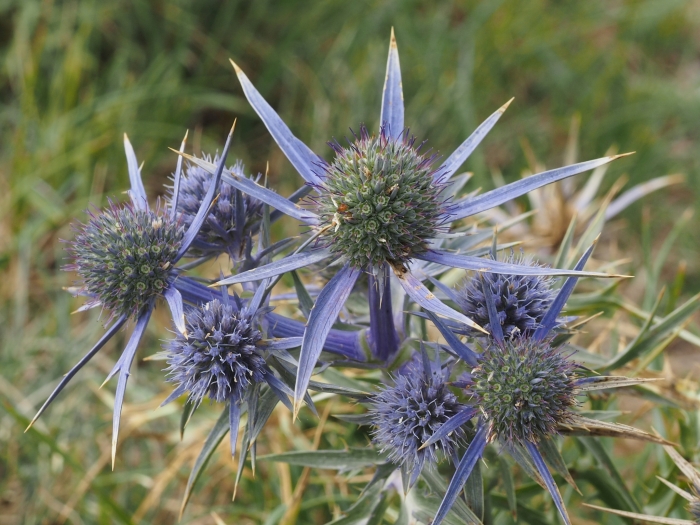Amethyst Eryngo
(Eryngium amethystinum)
Amethyst Eryngo (Eryngium amethystinum)
/
/

Mario Bassini
CC BY 4.0
Image By:
Mario Bassini
Recorded By:
Copyright:
CC BY 4.0
Copyright Notice:
Photo by: Mario Bassini | License Type: CC BY 4.0 | License URL: http://creativecommons.org/licenses/by/4.0/ | Rights Holder: Mario Bassini | Publisher: iNaturalist | Date Created: 2021-09-03T14:06:03-07:00 |

























Estimated Native Range
Summary
Eryngium amethystinum, commonly known as amethyst eryngo, is a clump-forming perennial herb native to grasslands and rocky areas in the eastern Mediterranean region, particularly Italy and the Balkans. It thrives in dry, calcium-rich soils and typically reaches heights of 12 to 20 inches (30 to 50 centimeters). This plant is characterized by its striking light blue to purple stems and leathery, spiny leaves that form a rosette at the base. During mid to late summer, it produces distinctive cylindrical umbels of silvery blue bracts that resemble thistles and are highly attractive to pollinators such as bees and butterflies.
Amethyst eryngo is appreciated for its unique ornamental qualities, including its metallic blue flower heads that add a touch of color and texture to borders, rock gardens, and xeriscaping. It is also used in dried flower arrangements due to the long-lasting nature of its bracts. In cultivation, Eryngium amethystinum requires well-drained soil, preferably alkaline, and full sun exposure to thrive. It is drought-tolerant once established, making it a low-maintenance choice for gardeners. While generally pest-free, it can occasionally suffer from root rot if grown in poorly drained soils.CC BY-SA 4.0
Amethyst eryngo is appreciated for its unique ornamental qualities, including its metallic blue flower heads that add a touch of color and texture to borders, rock gardens, and xeriscaping. It is also used in dried flower arrangements due to the long-lasting nature of its bracts. In cultivation, Eryngium amethystinum requires well-drained soil, preferably alkaline, and full sun exposure to thrive. It is drought-tolerant once established, making it a low-maintenance choice for gardeners. While generally pest-free, it can occasionally suffer from root rot if grown in poorly drained soils.CC BY-SA 4.0
Plant Description
- Plant Type: Herb
- Height: 1-2 feet
- Width: 1-2 feet
- Growth Rate: Slow, Moderate
- Flower Color: Blue, Purple
- Flowering Season: Summer
- Leaf Retention: Deciduous
Growth Requirements
- Sun: Full Sun
- Water: Low, Medium
- Drainage: Fast, Medium
Common Uses
Butterfly Garden, Deer Resistant, Drought Tolerant, Low Maintenance, Rock Garden, Street Planting
Natural Habitat
native to grasslands and rocky areas in the eastern Mediterranean region, particularly Italy and the Balkans
Other Names
Common Names: Amethyst Sea Holly, Italian Sea Holly, Italian Eryngo, Sapphire Blue Sea Holly
Scientific Names: , Eryngium amethystinum, Eryngium amethystinum f. cupreum, Eryngium amethystinum f. macrophyllum, Eryngium amethystinum f. trichophyllum, Eryngium amethystinum var. tenuifolium, Eryngium australe, Eryngium australe, Eryngium caeruleum, Eryngium dilatatum
GBIF Accepted Name: